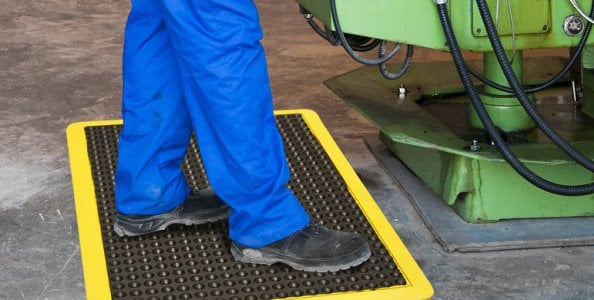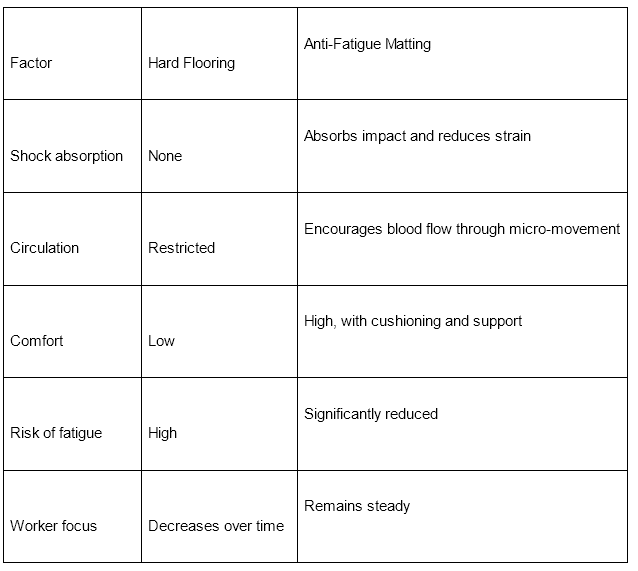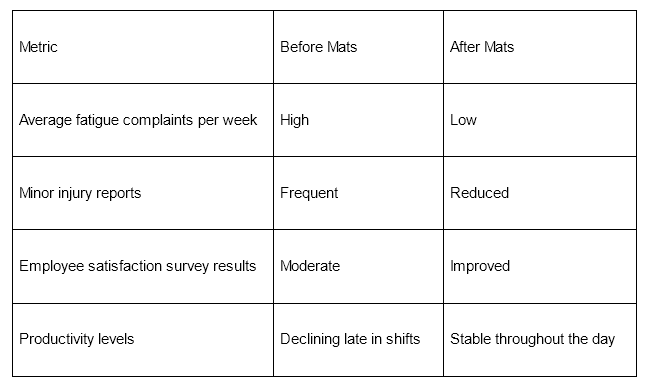Anti-Fatigue Floor Mats: The Overlooked Tool for Reducing Workplace Injuries

Across countless workplaces, employees spend most of their day on their feet. From factory floors and commercial kitchens to retail checkouts and warehouse aisles, standing is part of the job. What often goes unnoticed is how much strain that constant standing causes. Hard flooring, such as concrete or tiles, provides no give, forcing the body to absorb every bit of impact. Over time, this leads to muscle fatigue, lower back pain, and an increased risk of injury.
In many environments, employers focus on safety equipment and hazard prevention, yet they overlook one of the simplest improvements available: better flooring comfort. The use of anti-fatigue floor mats is a practical, low-cost measure that can dramatically reduce injury risks while improving day-to-day comfort for staff. When placed in key areas like workstations, counters, and production lines, these mats make an immediate difference that both employees and managers can feel.
Ignoring fatigue-related injuries is costly. It affects productivity, morale, and the company’s bottom line. Businesses that address it at the ground level literally tend to see results quickly.
How Fatigue Leads to Workplace Injuries
Standing for long hours forces the body into static postures. Unlike walking or sitting, which allow muscles to relax intermittently, standing keeps them under continuous tension. Blood circulation slows down, pressure builds in the lower limbs, and micro-vibrations travel through the joints. The body’s natural response is to compensate with small, repetitive movements that, over time, can lead to strain injuries.
Common outcomes include:
- Lower back pain: caused by continuous spinal compression.
- Knee and hip strain: due to a lack of cushioning underfoot.
- Foot conditions: such as plantar fasciitis or joint inflammation.
- Circulatory issues: as blood flow becomes restricted in static positions.
For employees on long shifts, this physical stress accumulates, reducing alertness and coordination. Fatigued workers are more prone to accidents such as slips, trips, or dropped items. It’s a chain reaction: physical fatigue leads to reduced focus, which in turn increases the likelihood of injury.
A study from Safe Work Australia reported that musculoskeletal disorders account for nearly one-third of all workplace injuries. Many of these are aggravated by prolonged standing. Small ergonomic improvements, particularly at the floor level, can significantly reduce such risks. Yet too often, they are left unaddressed in safety plans.
Why Traditional Safety Measures Aren’t Enough
Workplace safety programs tend to focus on visible hazards: machinery, chemicals, moving equipment, or fire risks. While these are important, they represent only part of the safety picture. The daily strain caused by poor ergonomics is far less visible, yet equally damaging.
Personal protective equipment (PPE) and proper footwear help, but they do not eliminate the underlying issue of hard flooring. Safety shoes provide some cushioning, but after several hours, even the best pair cannot prevent leg and back fatigue. Anti-slip coatings or signage reduce accidents on wet floors, but they do not address the gradual wear on the body.
.jpg)
To achieve a truly safe and sustainable working environment, employers need to consider comfort and injury prevention together. A supportive surface underfoot helps distribute pressure evenly, encourages micro-movements that improve blood flow, and reduces muscle strain throughout the body. In short, comfort is not a luxury; it’s a safety feature.
The Role of Anti-Fatigue Floor Mats in Injury Prevention
Anti-fatigue mats are specifically engineered to counteract the physical effects of standing. They are made from cushioned materials such as rubber, polyurethane, or vinyl, each designed to promote subtle, constant movement in the leg and calf muscles. These micro-movements stimulate blood circulation, reducing pressure build-up and preventing stiffness.
Below is a quick comparison of how they function versus traditional hard floors:

In addition to improving comfort, the mats reduce stress on joints and muscles, helping to prevent long-term musculoskeletal problems. In industries like retail and food service, where staff stand for extended shifts, the improvement in posture and endurance can be remarkable.
Safety benefits go beyond fatigue relief. Anti-fatigue mats also provide a stable, slip-resistant surface. Many are designed for wet or oily environments, ensuring grip and stability in areas where slips are common. The result is a safer, more productive workspace that supports both physical health and overall performance.
Employees working on assembly lines, behind counters, or at packing stations often report less pain and more energy when anti-fatigue mats are introduced. Reduced discomfort translates directly into fewer sick days and better productivity, a win for both staff and management.
Measuring the Real Impact: Health, Morale, and Productivity
Workplace safety initiatives are often evaluated through injury reports and absentee records. When anti-fatigue mats are implemented, the difference can be clearly seen in both metrics. Some companies note a reduction in minor injury claims and staff turnover, particularly in roles that require long hours of standing.
According to research from ergonomics specialists, workers who stand on cushioned mats experience up to 50% less fatigue compared to those standing on concrete or tiles. This translates into measurable improvements in focus, reaction time, and general job satisfaction.
Beyond the numbers, there’s a psychological benefit. Employees feel that their comfort and well-being are valued, which fosters loyalty and engagement. A small ergonomic improvement, like the introduction of anti-fatigue mats, can influence workplace culture in a positive way.
To illustrate the difference, consider this simple comparison:

When viewed collectively, these figures show how an inexpensive safety addition can create a ripple effect across an entire organisation. Workers stay focused longer, experience fewer injuries, and perform tasks with more accuracy. It’s a shift that benefits the company’s financial performance as much as its safety record.
Could Anti-Fatigue Mats Be the Missing Link in Workplace Safety?
The prevention of workplace injuries often comes down to the small things. Anti-fatigue mats might not appear as sophisticated as advanced machinery or ergonomic workstations, yet their impact is profound. They reduce strain, promote movement, and create a safer environment without major structural changes or expensive installations.
Many employers focus on the cost of implementing safety measures, but few calculate the hidden expense of fatigue-related injuries. The financial loss from absenteeism, lower productivity, and compensation claims can far exceed the investment in preventive solutions like anti-fatigue mats.
When businesses introduce these mats, they often notice improvements beyond physical comfort. Staff stay alert for longer periods, morale increases, and customer service quality improves. Employees who feel physically supported are more likely to take pride in their work and less likely to suffer chronic pain that forces time off.
If you think about safety as a layered system, flooring comfort forms the foundation. The right surface supports everything above it: people, performance, and long-term workplace health. A comfortable floor may not sound like a major safety upgrade, yet it’s often the one that matters most.
So, the question is: can your workplace afford to overlook something as simple as anti-fatigue mats?
.jpg)
.jpg)
